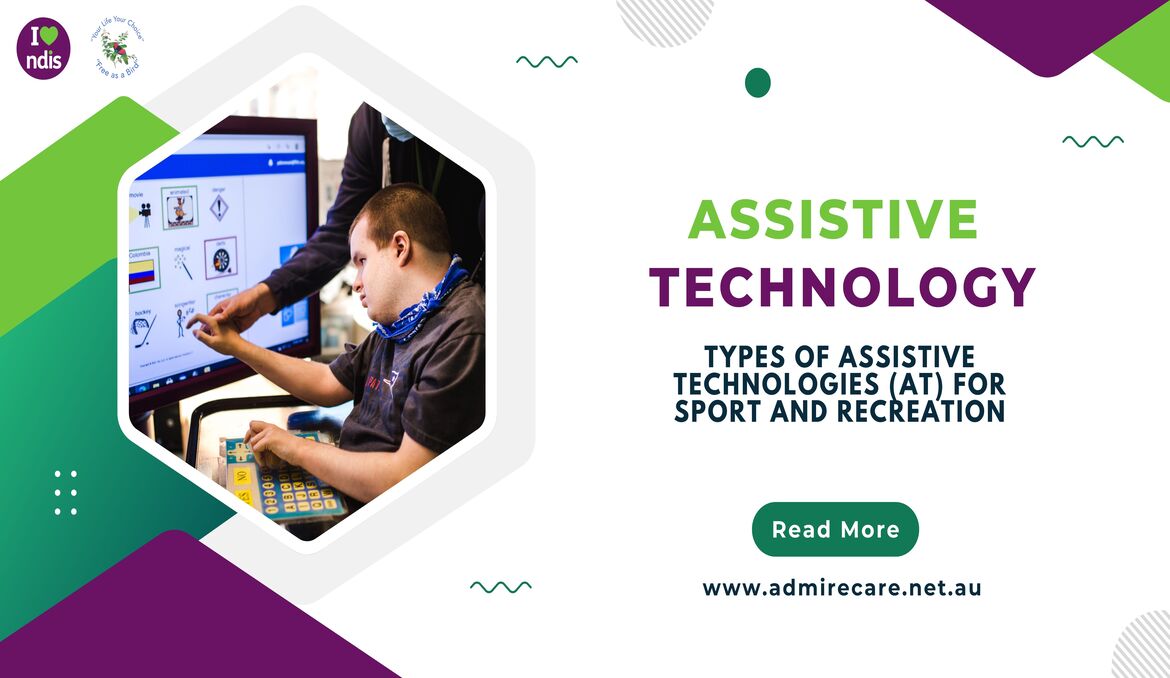Types of Assistive Technologies (AT) for Sport and Recreation
The commitment and sheer involvement of the National Disability Insurance Scheme, aka NDIS, in transforming the lives of people with disabilities is unparalleled. The mind behind this initiative is tirelessly working hard to bring all possible solutions to enhance disabled individuals' lives across Australia. This prospect has led to many unified approaches, and Assistive Technology for sports and recreation is one of its peak innovations.
In this blog post, we will unveil the role of Assistive Technology (AT) in sports. We will discuss how it enhances disabled individuals' sports interests using advanced AT technology and gives them the flexibility and quality assurance to thrive in their sports hobbies.
Introduction of Assistive Technology (AT) in Sports
Assistive Technology, or AT, in sports, refers to an array of advanced devices designed to enhance mobility and help disabled individuals play their favorite sports they would otherwise be unable to. Disabled participants with AT can participate safely and become victorious. Over the years, the demand for AT in sports has grown rapidly among disabled individuals. The recent Paralympic Games and other significant sports events show how athletes use assistive technology. For the past ten years, many Paralympic athletes have used different assistive technology to improve sports like cycling and running
Types of Assistive Technology in Sports
Customized Wheelchair
One popular type of mobility assistive technology is the sports wheelchair. Unlike standard ones, sports wheelchairs are designed for various sports, such as basketball, rugby, and tennis. They are lightweight, highly flexible, and customized to meet the specific needs of each sportsperson.
Prosthetics
A prosthetic is an artificial body part typically constructed from plastic, carbon fiber, or silicone. Individuals with disabilities commonly use them for their lower/upper limbs, hands, or arms.
Unlike a regular prosthetic, a running blade bends and gives push-off, usually in a fixed position. Hand or arm prosthetics provide a stabilizing function that can help improve balance. They can also be specifically designed for golf, archery, or fishing.
Visually Impaired AT Technologies
Assistive Technologies are essential for athletes with visual impairments in helping them navigate and participate in sports. Goalball, a sport designed specifically for visually impaired athletes, uses a ball with bells inside, allowing players to track its movement by sound.
Hearing Impaired AT Technologies
Athletes with difficulty hearing often rely on visual signals and vibration devices to understand important information during sports. For example, flashing lights can show when a race is starting. Vibration devices can also help athletes by giving them important messages, such as when another competitor is coming near.
AT for Standing Support
This technology helps athletes with disabilities to participate actively in standing sports. If you use this technology for standing sports, you will receive the following support:
Crutches:Crutches are lightweight metal devices that provide extra stability and balance for walking. They also allow people who need adapted crutches to participate in team sports, including soccer and skiing.
Walking Frame:Walking Frame devices help people walk independently and offer different levels of support depending on their needs. They are usually made of metal, and users can steer them with their hands. They work best on smooth surfaces because they have small wheels that don't work well on grass or bumpy ground.
Sports Using Assistive Technology
- Adaptive Bowling
- Adaptive Archery
- Adaptive Golf
- Adaptive Shooting
- Adaptive Table Tennis
- Handcycling
- Power Soccer
- Wheelchair Basketball
- Wheelchair Curling
- Wheelchair Fencing
- Wheelchair Baseball
- Wheelchair Table Tennis
- Wheelchair Tennis
- Wheelchair Volleyball
- Wheelchair Weightlifting
Recreation-Specific Assistive Technologies
Assistive Technologies (AT) play a vital role in improving the participation of disabled individuals in recreational sports activities. Specifically, adaptive equipment designed for hiking, kayaking, and skiing has opened opportunities for people with disabilities to experience and enjoy the great outdoors. These technologies provide access and promote inclusion and independence, allowing individuals to engage in outdoor activities that suit their abilities and preferences.
NDIS Funding for Assistive Technology (AT)
Two categories in the Capital Supports Budget are designed to provide assistive technology (AT) to help you achieve your goals.
Assistive Technology (AT): The plan covers specialized technology you may need, such as wheelchairs, prosthetics, and orthotics.
PACE Assistive Technology Maintenance, Repair, Rental:This policy covers ongoing and expanded activities, such as assistive technology, including equipment rental, flexible packages for changing needs, and repairs and maintenance.
Final Thoughts
The rise of assistive technology in sports has made things easy for athletes who previously found it challenging to consider participation. The comprehensive use of appropriate AT can now take them closer to their sports goal and help them win big on the global stage. However, the challenge of accessing AT under the correct supervision is still a segment to worry about for many.
Admire Care is a registered NDIS provider in Perth that provides end-to-end Assistive Technology service and support to needy people with disabilities. We feature the most agile and experienced team, ready to assist you in understanding the core concepts of AT and enable the right equipment to thrive in life. Contact us today!

 Increase Text
Increase Text
 Decrease Text
Decrease Text High Constract
High Constract Links Underline
Links Underline Readable Font
Readable Font Reset
Reset